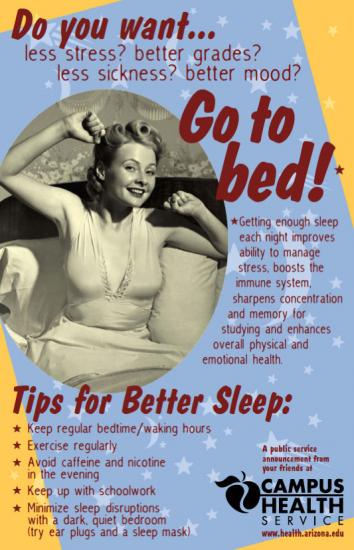Published: August 30, 2011

A campus media campaign at the University of Arizona–Tucson was effective in raising sleep as a health issue and in getting students to sleep better and longer.Credit: University of Arizona
Sleep often suffers in a student’s freshman year, but a new study finds that young college students may think their sleep quality is better than it is. The study also demonstrates that a low-cost campus wide media campaign can help some students sleep better and suggests that discussing sleep problems may be a gateway for college health providers to address more sensitive problems.
When Kathryn Orzech attended the College of William and Mary in Virginia, she participated in drama and choir. Rehearsals that would have ended at 10 p.m. in high school now went much later. Social opportunities around the dorm — card games, trips to late-night snack hangout spots — beckoned but without parents around to wield the cudgel of a curfew.
For a long list of reasons, college freshmen are often sub-par sleepers. A new study by Orzech, now a postdoctoral fellow in sleep research at Brown University, and student health officials at the University of Arizona, illuminates some of the factors undermining sleep. The research published in the current issue of the Journal of American College Health also indicates that college students think their sleep is better than it is and that a campus wide media intervention costing less than $2,500 was able to help nearly 10 percent of students find ways to sleep better. Curious? Continue reading
Source: Brown University
Published: August 29, 2011

Getty images
New research from the University of Montreal shows that inattention, rather than hyperactivity, is the most important indicator when it comes to finishing a high school education. “Children with attention problems need preventative intervention early in their development,” explained lead author Dr. Jean-Baptiste Pingault, who is also affiliated with Sainte-Justine Mother and Child University Hospital. The researchers came to their conclusion after looking at data collected from the parents and teachers of 2000 children over a period of almost twenty years.
In this study, attention problems were evaluated by teachers who looked for behaviour such as an inability to concentrate, absentmindedness, or a tendency to give up or be easily distracted. Hyperactivity was identified by behaviour such as restlessness, running around, squirming and being fidgety. The researchers found that only 29% of children with attention problems finished high school compared to 89% of children who did not manifest these inattention problems. When it came to hyperactivity, the difference was smaller: 40% versus 77%. After correcting the data for other influencing factors, such as socioeconomic status and health issues that are correlated with ADHD, inattention still made a highly significant contribution which was not the case for hyperactivity. [continue reading…]
Published: August 29, 2011

istockphoto
s if heavy course loads, on-campus activities and busy social calendars weren’t enough for college students to juggle, they also now carry the weight of a stagnant job market, record job insecurity and a high unemployment rate.
The pressure for peak performance and an on-call-24/7 mentality in the professional world continue to increase. Two-thirds of Americans have admitted to sleeping with their cell phones right next to their beds.
So, how can today’s college students prepare for the expectations of tomorrow’s workforce without burning out before earning their Bachelors’ degrees?
Counselors and career advisors at
Wake Forest University have teamed up to develop the following tips to help students deal with job-related stress before their admirable work ethic becomes an unhealthy work obsession.
[continue reading…]
Published: August 29, 2011
Scientific American looks at large parental age differences and questions whether they contribute to an increased the risk for psychiatric disorders.
A mother’s age is often considered a genetic risk factor for offspring, but research is now pointing the finger at fathers, too—particularly when it comes to the mental health of their progeny. Males may have the advantage of lifelong fertility, but as they grow older, the rate of genetic mutations passed on via their sperm cells increases significantly—putting their children at increased risk for psychiatric disorders, especially autism and schizophrenia. Two recent studies support this link at least associatively, but experts remain uncertain if age is the cause of these problems. link to read article
Source: Scientific American



